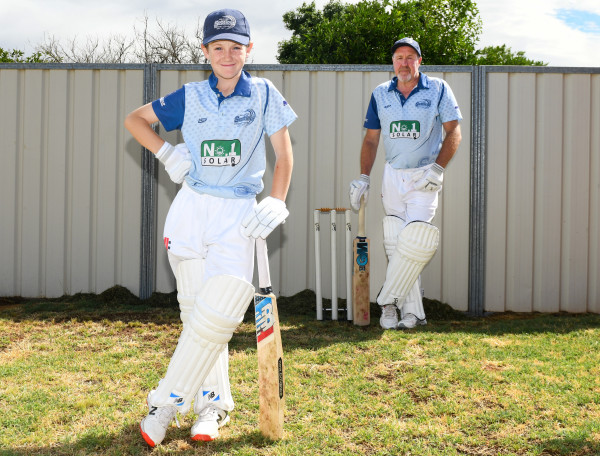KRUZE McVeigh-Myers opened the bowling for Settlers’ fourth-division cricket side last week and knocked over both openers, after earlier scoring a handy 14 runs with the bat in the one-day clash.
That’s a decent day for any men’s grade all-rounder, but even better when you’re only nine years old.
Kruze has been regularly playing in the fourths this season after last year getting a taste of senior cricket as an even younger substitute fielder, but last week’s one-dayer against Nichols Point was special, because he was playing alongside dad Andrew Myers, 54, in the older player’s 300th game.
Andrew, another all-rounder, also took two wickets, the number three and four batters, and made 34 with the bat.
Father and son finished the day with a comfortable victory for their club and immense pride in each other.
“It was very special. You don’t get to that every day,” said Andrew, who has played in all SCA senior grades since the 1992-93 season, and was told by the club last week that he has made more than 7000 runs and taken more than 450 wickets.
“We didn’t know he (Kruze) was going to open the bowling, but it was decided on the day that he would, which is even more special,” he said.
Kruze, a Mildura South Primary School student, also plays above his age in juniors and opens the bowling for the under-14 side.
Asked if he was given respect by the grown-ups he plays against, he smiled and said: “Yeah, sometimes”.
Opposition fast bowlers, he said, did slow down a bit for him when he was batting, but “if I play a good shot … they’ll start speeding up”.
Andrew said that because all clubs these days had very young players in their sides, a culture had evolved around encouragement.
“We really want to encourage the kids to play, because there’s a bit of a shortage in numbers in cricket, so if they come out to bat you slow down and pitch the ball up, that sort of thing,” he said.
“It’s good that the young kids are playing because, if they don’t play, they’re going to lose interest and then they’re gone.”
“When he (Kruze) goes out, they (the opposition) pitch the ball up and offer encouragement.”
Kruze certainly feels encouraged and is loving his cricket in both juniors and seniors.
His cricket ambitions are to play for Victoria, then Australia, and his favourite player is fast bowler Mitchell Starc.
But his real cricket hero is clearly his father. Last weekend’s match, he said, had most importantly be been an opportunity to “have some fun with dad”.
FATHERS, SONS RULE
That’s exactly what’s happening in the Sunraysia Cricket Association’s lowest senior men’s grade, though, as team lists increasingly include young boys, many of whom are playing with their fathers.







